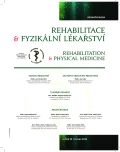Sacralization of Vertebra L5
Authors:
R. Bednár; G. Majeríková
Authors‘ workplace:
Odd. FBLR, FNsP, F. D. Roosevelta, Banská Bystrica
primár MUDr. G. Majeríková
Published in:
Rehabil. fyz. Lék., 23, 2016, No. 2, pp. 119-124.
Category:
Case Report
Overview
The literature on the occurrence of transition lumbosacral vertebra in the population reports the range of 4 and 36%. This wide range result from differential approaches to diagnosis and classification criteria. Sacralization of L5 is more common than lumbarization and occurs in the range of 1.7 to 14% (4).
The transition states of vertebra L5 include several degrees of articular connections between transversal processus L5 and the first sacral segment. Castellvi classified variations of lumbosacral transition of vertebra into four groups: Type I – dysplastic processus transversus, type II – incomplete lumbarization/sacralizátion with unilateral or bilateral pseudoarthrosis, type III – complete lumbarization/ sacralization, and type IV – combined state (4). Asymmetric sacralization or lumbarization (sc. megatransversus or Bartolotti’s syndrome) is probably the source of chronic pain. Neoarthrosis between hypertrophic transversal processus on one side, atypically loaded, pried/levered/wrested joint on the opposite side or overloaded segment above the affected side, where mobility is minimal, can be the source of chronic pain in various degree (2).
The reported case concerns a 50 year female patient with chronic spine pain, where we determined a complete fusion of L5-S1 segment of IIIrd degree according to Castellvi. A complex rehabilitation therapy resulted in adjustment of the patient’s complains, but in our opinion that the patient is at risk.
Overload of high segments above the block, which compensates the loss of one segment, follows to acceleration of degenerative changes and lesions of intervertebral disk in lumbar region up to possible development of radicular syndrome.
Keywords:
transition vertebra, sacralization of L5, congenital block
Sources
1. BULUT, M., UCAR B. Y., UCAR, D. et al.: In sacralisationreally a cause of low back pain ? ISRN Orthop. 2013, 7, doi: 10.1155/2013/839013.
2. DUNGL, P. a kol.: Ortopedie. 2. přepracované a doplněné vydání, Grada, Praha, 2014, s. 437, 438, 486.
3. DZUPA, V., SLEPANEK, M., STRIZ, M. et al.: Developmental malformations in the area of the lumbosacral transitional vertebrae and sacrum: differences in gender and left/right distribution. Surg. Radiol. Anat, 36, 2014, s. 689-693.
4. FRENCH, D. H., SOMASUNDARAM, A. J., SCHAEFER, N. R, LAHERTY, R. W.: Lumbosacral transitional vertebrae and its prevalence in the australian population. Global Spine Journal, 2014, 4, s. 229-232.
5. KONIN, G. P., WALZ, D. M.: Lumbosacral transitional vertebrae: clasification, imaging findings, and clinical relevance, AJNR Am. J. Neuroradiol., roč. 31, s. 1778-1786.
6. MAHATO, N. K.: Morphometric analysis and identification of characteristic features in sacra bearing accessory articulations with L5 vertebrae. The Spine Journal, 2010, 10, s. 616-621.
7. MOON, S. M., KIM, S. S., YOON, M. G. et. al.: Radiographic assessment of effect of congenital monosegment synostosis of lower cervical spine between C2-C6 on adjacent mobile segments. Asian Spine Journal, 8, 2014, 5, s. 615-623.
8. REPKO, M., KRBEC, M., BURDA, J. et al.: Prostá kostěná fúze a instrumentovaná hemivertebrektomie v operační léčbě kongenitálních skolióz, Acta Chir. Orthop. Traum. Čech, 2008, 3, s. 175-180.
9. SON, K. M., LEE, S. M., LEE, G. W., AHN, M. H. et al.: The impact of lumbosacral transitional vertabrae on therapeutic outcomes of transforaminal epidural injection in patients with lumbar disc herniation, Pain Practice, 27, 2015, doi: 10.1111/papr.12315. [Epub ahead of print].
Labels
Physiotherapist, university degree Rehabilitation Sports medicineArticle was published in
Rehabilitation & Physical Medicine

2016 Issue 2
- Hope Awakens with Early Diagnosis of Parkinson's Disease Based on Skin Odor
- Deep stimulation of the globus pallidus improved clinical symptoms in a patient with refractory parkinsonism and genetic mutation
Most read in this issue
- Sacralization of Vertebra L5
- Positioning Chronically Immobile and Terminally-Ill Patients
- Options of Physiotherapy for Patients with Kidney Disease, on Dialysis and after Kidney Transplantation - Overview from Past to Present
- Spectrum, Trends and Approaches in Contemporary Neurorehabilitation
